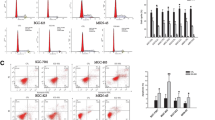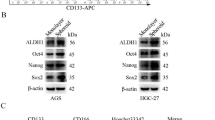Abstract
Objective
To investigate a previously uncharacterized function of Sijunzi Decoction (SJZD) in inhibition of gastric cancer stem cells (GCSCs).
Methods
MKN74 and MKN45, two CD44 positive gastric cancer cell lines with stem cell properties were used. The cells were divided into 2 groups. Treatment group was treated with SJZD (1–5 mg/mL) for indicated time (48 h–14 days). The control group was treated with equal volume of phosphate buffered saline. Cell Counting Assay Kit-8 were used to measure cell viability. Spheroid colony formation and GCSCs marker expression were performed to determine GCSCs stemness. Cell fractionation and chromatin immunoprecipitation assays were used to assess the distribution and DNA-binding activity of β-catenin after SJZD treatment, respectively.
Results
SJZD treatment repressed cell growth and induced apoptosis in MKN74 and MKN45 cell lines (P<0.05). Moreover, SJZD dramatically inhibited formation of spheroid colony and expression of GCSC markers in GC cells (P<0.05). Mechanistically, SJZD reduced nuclear accumulation and DNA binding activity of β-catenin (P<0.05), the key regulator for maintaining CSC stemness.
Conclusion
SJZD inhibits GCSCs by attenuating the transcriptional activity of β-catenin.
Similar content being viewed by others
References
Guo JH, Chen G, Yang SQ, Wei MH, Chen X. Clinical observation of the role of Chenxia Sijunzi Decoction in promoting the recovery of gastrointestinal function in critically ill patients. Chin Crit Care Med (Chin) 2012;24:674–676.
Liu L, Han L, Wong DY, Yue PY, Ha WY, Hu YH, et al. Effects of Si-Jun-Zi Decoction polysaccharides on cell migration and gene expression in wounded rat intestinal epithelial cells. Br J Nutr 2005;93:21–29.
Zhong WR, Huang YX, Cui JP. Clinical study on modified Sijunzi Decoction in treating intestinal metaplasia of gastric mucosa. Chin J Integr Tradit West Med (Chin) 1997;17:462–464.
Chen GZ, Fu D. Effect of Jiawei Sijunzi Decoction on migrating myoelectric complex in 8 Gy irradiated rats. Chin J Integr Tradit West Med (Chin) 1996;16:221–223.
Liu Y, Yang J, Cai Z. Chemical investigation on Sijunzi Decoction and its two major herbs Panax ginseng and Glycyrrhiza uralensis by LC/MS/MS. J Pharm Biomed Anal 2006;41:1642–1647.
Wang L, Jiang Q, Hu J, Zhang Y, Li J. Research progress on chemical constituents of Lonicerae japonicae flos. Biomed Res Int 2016;2016:8968940.
Jie Y, He W, Yang X, Chen W. Kruppel-like factor 4 acts as a potential therapeutic target of Sijunzi Decoction for treatment of colorectal cancer. Cancer Gene Ther 2017;24:361–366.
Jia J, Qin Y, Zhang L, Guo C, Wang Y, Yue X, et al. Sijunzi Decoction-treated rat serum induces apoptosis of side population cells in gastric carcinoma. Exp Ther Med 2018;15:1718–1727.
Chen L, Jin T, Ning C, Wang S, Wang L, Lin J. Anti-tumor and immune-modulating effect of Jiawei Sijunzi Decoction in mice bearing hepatoma H22 tumor. J Southern Med Univ (Chin) 2019;39:241–248.
Torre LA, Bray F, Siegel RL, Ferlay J, Lortet-Tieulent J, Jemal A. Global cancer statistics, 2012. CA Cancer J Clin 2015;65:87–108.
Park JY, von Karsa L, Herrero R. Prevention strategies for gastric cancer: a global perspective. Clin Endosc 2014;47:478–489.
Clarke MF, Dick JE, Dirks PB, Eaves CJ, Jamieson CH, Jones DL, et al. Cancer stem cells-perspectives on current status and future directions: AACR Workshop on cancer stem cells. Cancer Res 2006;66:9339–9344.
Yang YC, Wang SW, Hung HY, Chang CC, Wu IC, Huang YL, et al. Isolation and characterization of human gastric cell lines with stem cell phenotypes. J Gastroenterol Hepatol 2007;22:1460–1468.
Gong X, Azhdarinia A, Ghosh SC, Xiong W, An Z, Liu Q, et al. LGR5-targeted antibody-drug conjugate eradicates gastrointestinal tumors and prevents recurrence. Mol Cancer Ther 2016;15:1580–1590.
Nguyen PH, Giraud J, Staedel C, Chambonnier L, Dubus P, Chevret E, et al. All-trans retinoic acid targets gastric cancer stem cells and inhibits patient-derived gastric carcinoma tumor growth. Oncogene 2016;35:5619–5628.
Shitara K, Doi T, Nagano O, Imamura CK, Ozeki T, Ishii Y, et al. Dose-escalation study for the targeting of CD44v(+) cancer stem cells by sulfasalazine in patients with advanced gastric cancer (EPOC1205). Gastric Cancer 2017;20:341–349.
Bekaii-Saab T, El-Rayes B. Identifying and targeting cancer stem cells in the treatment of gastric cancer. Cancer 2017;123:1303–1312.
Holland JD, Klaus A, Garratt AN, Birchmeier W. Wnt signaling in stem and cancer stem cells. Curr Opin Cell Biol 2013;25:254–264.
White BD, Chien AJ, Dawson DW. Dysregulation of Wnt/beta-catenin signaling in gastrointestinal cancers. Gastroenterology 2012;142:219–232.
MacDonald BT, Tamai K, He X. Wnt/beta-catenin signaling: components, mechanisms, and diseases. Dev Cell 2009;17:9–26.
He TC, Sparks AB, Rago C, Hermeking H, Zawel L, da Costa LT, et al. Identification of c-MYC as a target of the APC pathway. Science 1998;281:1509–1512.
Ibrahim EE, Babaei-Jadidi R, Saadeddin A, Spencer-Dene B, Hossaini S, Abuzinadah M, et al. Embryonic NANOG activity defines colorectal cancer stem cells and modulates through AP1- and TCF-dependent mechanisms. Stem Cells 2012;30:2076–2087.
Lee SH, Koo BS, Kim JM, Huang S, Rho YS, Bae WJ, et al. Wnt/beta-catenin signalling maintains self-renewal and tumourigenicity of head and neck squamous cell carcinoma stem-like cells by activating Oct4. J Pathol 2014;234:99–107.
Amable G, Martinez-Leon E, Picco ME, Di Siervi N, Davio C, Rozengurt E, et al. Metformin inhibits beta-catenin phosphorylation on Ser-552 through an AMPK/PI3K/Akt pathway in colorectal cancer cells. Int J Biochem Cell Biol 2019;112:88–94.
Yong X, Tang B, Xiao YF, Xie R, Qin Y, Luo G, et al. Helicobacter pylori upregulates Nanog and Oct4 via Wnt/beta-catenin signaling pathway to promote cancer stem cell-like properties in human gastric cancer. Cancer Lett 2016;374:292–303.
Zhang J, Huang K, Shi Z, Zou J, Wang Y, Jia Z, et al. High beta-catenin/Tcf-4 activity confers glioma progression via direct regulation of AKT2 gene expression. Neur Oncol 2011;13:600–609.
Takaishi S, Okumura T, Tu S, Wang SS, Shibata W, Vigneshwaran R, et al. Identification of gastric cancer stem cells using the cell surface marker CD44. Stem Cells 2009;27:1006–1020.
Lu Y, Li L, Zhang JW, Zhong XQ, Wei JA, Han L. Total polysaccharides of the Sijunzi Decoction attenuate tumor necrosis factor-alpha-induced damage to the barrier function of a Caco-2 cell monolayer via the nuclear factor-kappaB-myosin light chain kinase-myosin light chain pathway. World J Gastroenterol 2018;24:2867–2877.
Li Y, Gong L, Qi R, Sun Q, Xia X, He H, et al. Paeoniflorin suppresses pancreatic cancer cell growth by upregulating HTRA3 expression. Drug Des Devel Ther 2017;11:2481–2491.
Gong L, Liu F, Xiong Z, Qi R, Luo Z, Gong X, et al. Heterochromatin protects retinal pigment epithelium cells from oxidative damage by silencing p53 target genes. Proc Natl Acad Sci U S A 2018;115:E3987–E3995.
Guan Z, Wang M, Cai Y, Yang H, Zhao M, Zhao C. Rapid characterization of the chemical constituents of Sijunzi Decoction by UHPLC coupled with fourier transform ion cyclotron resonance mass spectrometry. J Chromatogr B Analyt Technol Biomed Life Sci 2018;1086:11–22.
Xu Q, Yu H, Wu H, Gong L, Pan Y, Qiu Y. Simultaneous determination of four components in Sijunzi Decoction by HPLC. Chin J Exp Tradit Med Formulae (Chin) 2013;19:62–65.
Karimian A, Ahmadi Y, Yousefi B. Multiple functions of p21 in cell cycle, apoptosis and transcriptional regulation after DNA damage. DNA Repair 2016;42:63–71.
Morata-Tarifa C, Jimenez G, Garcia MA, Entrena JM, Grinan-Lison C, Aguilera M, et al. Low adherent cancer cell subpopulations are enriched in tumorigenic and metastatic epithelial-to-mesenchymal transition-induced cancer stemlike cells. Sci Rep 2016;6:18772.
Amaral RLF, Miranda M, Marcato PD, Swiech K. Comparative analysis of 3D bladder tumor spheroids obtained by forced floating and hanging drop methods for drug screening. Front Physiol 2017;8:605.
Tian T, Zhang Y, Wang S, Zhou J, Xu S. Sox2 enhances the tumorigenicity and chemoresistance of cancer stem-like cells derived from gastric cancer. J Biomed Res 2012;26:336–345.
Hutz K, Mejias-Luque R, Farsakova K, Ogris M, Krebs S, Anton M, et al. The stem cell factor SOX2 regulates the tumorigenic potential in human gastric cancer cells. Carcinogenesis 2014;35:942–950.
Harkonen K, Oikari S, Kyykallio H, Capra J, Hakkola S, Ketola K, et al. CD44s assembles hyaluronan coat on filopodia and extracellular vesicles and induces tumorigenicity of MKN74 gastric carcinoma cells. Cells 2019;8:276–295
Fang D, Hawke D, Zheng Y, Xia Y, Meisenhelder J, Nika H, et al. Phosphorylation of beta-catenin by AKT promotes beta-catenin transcriptional activity. J Biol Chem 2007;282:11221–11229.
Li CC, Le K, Kato J, Moss J, Vaughan M. Enhancement of beta-catenin activity by BIG1 plus BIG2 via Arf activation and cAMP signals. Proc Natl Acad Sci U S A 2016;113:5946–5951.
Reya T, Clevers H. Wnt signalling in stem cells and cancer. Nature 2005;434:843–850.
Nguyen LV, Vanner R, Dirks P, Eaves CJ. Cancer stem cells: an evolving concept. Nat Rev Cancer 2012;12:133–143.
Pai SG, Carneiro BA, Mota JM, Costa R, Leite CA, Barroso-Sousa R, et al. Wnt/beta-catenin pathway: modulating anticancer immune response. J Hematol Oncol 2017;10:101.
Author information
Authors and Affiliations
Contributions
Li YJ, Liao LL, and Liu P carried out the experiments and wrote the paper. Tang P and Wang H prepared Sijunzi Decoction and analyzed the data. All the authors discussed the data. Peng QH designed and supervised the overall study.
Corresponding author
Ethics declarations
All authors declare no conflicts of interest.
Additional information
Supported by National Natural Science Foundation of China (No. 81703916), Natural Science Foundation of Hunan Province (No. 2018JJ6042)
Electronic supplementary material
Rights and permissions
About this article
Cite this article
Li, Yj., Liao, Ll., Liu, P. et al. Sijunzi Decoction Inhibits Stemness by Suppressing β-Catenin Transcriptional Activity in Gastric Cancer Cells. Chin. J. Integr. Med. 28, 702–710 (2022). https://doi.org/10.1007/s11655-021-3314-9
Accepted:
Published:
Issue Date:
DOI: https://doi.org/10.1007/s11655-021-3314-9




